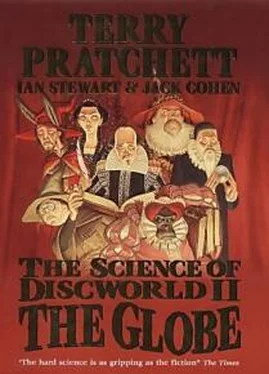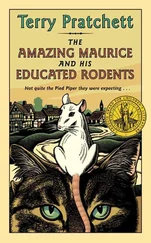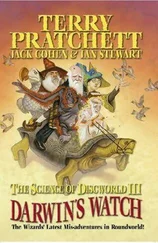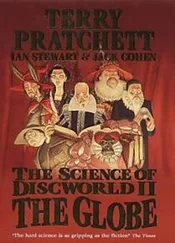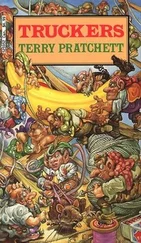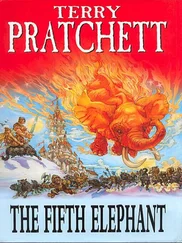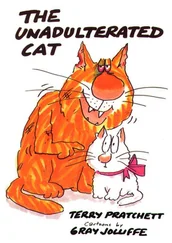Terry Pratchett - The Science of Discworld II - The Globe
Здесь есть возможность читать онлайн «Terry Pratchett - The Science of Discworld II - The Globe» весь текст электронной книги совершенно бесплатно (целиком полную версию без сокращений). В некоторых случаях можно слушать аудио, скачать через торрент в формате fb2 и присутствует краткое содержание. Жанр: Фантастика и фэнтези, на английском языке. Описание произведения, (предисловие) а так же отзывы посетителей доступны на портале библиотеки ЛибКат.
- Название:The Science of Discworld II - The Globe
- Автор:
- Жанр:
- Год:неизвестен
- ISBN:нет данных
- Рейтинг книги:5 / 5. Голосов: 1
-
Избранное:Добавить в избранное
- Отзывы:
-
Ваша оценка:
- 100
- 1
- 2
- 3
- 4
- 5
The Science of Discworld II - The Globe: краткое содержание, описание и аннотация
Предлагаем к чтению аннотацию, описание, краткое содержание или предисловие (зависит от того, что написал сам автор книги «The Science of Discworld II - The Globe»). Если вы не нашли необходимую информацию о книге — напишите в комментариях, мы постараемся отыскать её.
The Science of Discworld II - The Globe — читать онлайн бесплатно полную книгу (весь текст) целиком
Ниже представлен текст книги, разбитый по страницам. Система сохранения места последней прочитанной страницы, позволяет с удобством читать онлайн бесплатно книгу «The Science of Discworld II - The Globe», без необходимости каждый раз заново искать на чём Вы остановились. Поставьте закладку, и сможете в любой момент перейти на страницу, на которой закончили чтение.
Интервал:
Закладка:
How did it actually happen on Roundworld? Here, the whole process took a mere five million years. One hundred thousand Grandfathers [28] A time measurement we developed in The Science of Discworld as a 'human' way of measuring large amounts of time. It's 50 years, a 'typical' age gap between grandparent and grandchild. Most of the really interesting bits of human development have taken place in the last 150 Grandfathers. Remember objects in the rear view mirror are closer than they appear.
ago, we and the chimpanzees shared a distant ancestor. The chimpanzeelike ancestor of Man was also the Manlike ancestor of the chimpanzee.
To us, it would have looked astonishingly like a chimpanzee -but to a chimpanzee, it would have looked astonishingly like a human.
DNA analysis shows, beyond any shadow of reasonable doubt, that our closest living relatives are chimpanzees: the ordinary ('robust') chimpanzee Pan troglodytes and the more slender ('gracile') bonobo Pan paniscus, often politically incorrectly called the pygmy chimpanzee. Our genomes have 98 per cent in common with both, leading Jared Diamond to refer to humans as 'the third chimpanzee' in a book of the same title.
The same DNA evidence indicates that we and today's chimpanzees parted company, specieswise, those five million yean (100,000 Grandfathers) ago. That figure is debatable, but it can't be very far wrong. The gorillas split off a little earlier. The earliest fossils of our 'hominid'
ancestors are found in Africa, but there are numerous later fossilised hominids from other parts of the world such as China and Java. The oldest known are two species of Australopithecus, each about 4-4.5 million years old. The Australopithecines had a good run: they hung around until about 1-1.5 million years ago, at which point they gave way to genus Homo: Homo rudolfensis, Homo habilis, Homo erectus, Homo ergaster, Hot heidelbergensis, Homo neanderthalensis, and finally us, Homo sapiens. And somehow another Australopithecine inserted itself into the middle of those Homos. In fact the more hominid fossils we find, the more complicated our conjectured ancestry becomes, and it now looks as if many different hominid species coexisted on the plains of Africa for most of the past five million years.
Today's chimpanzees are quite bright, probably a lot brighter than the apes that the Dean tried to teach spelling to. Some remarkable experiments have shown that chimps can understand a simple version of language, presented to them as symbolic shapes. They can even form simple concepts and make abstract associations, all within a linguistic frame. They can't build a space elevator, and they never will unless they evolve considerably and avoid being killed for 'bush meat'.
We can't build one either, but it might take no more than a couple of hundred years before the things are sprouting all along the equator. All you need is a material with enough tensile strength, perhaps some composite involving carbon nanotubes. Then you dangle cable from geostationary satellites, hang elevator compartments from them, equip them with suitable space elevator music ... after which, leaving the planet becomes entirely straightforward. The energy cost, hence the marginal financial cost, is near enough zero, because for everything that needs to go up, something else needs to come down. It could be moon rock, or platinum mined in the asteroid belt, or the astronaut that the person going up is due to replace on duty. The capital cost of such a project is enormous, though, which is why we're not in any great hurry right now.
The big scientific problem in this connection is: how can evolution get so quickly from an ape that can't compete mentally with a chimpanzee to a godlike being that can write poetry as good as Shakespeare's, and has advanced so rapidly from that point that it will surely soon erect (drop) a space elevator? 100,000 Grandfathers hardly seems long enough, given that it took about 50 million Grandfathers [29] Most of them being Grandfather bacteria, you appreciate. That's the trouble with metaphors.
to get from a bacterium to the first chimpanzee.
Something that dramatic needed a new trick. That trick was the invention of culture. Culture allowed any individual ape to make use of the ideas and discoveries of thousands of other apes. It let the ape collective acquire knowledge cumulatively, so that it didn't all get lost when its owner died. In Figments of Reality we coined the term 'extelligence' for this suite of tricks, and the word is beginning to become common currency. Extelligence is like our own personal intelligence, but it lives outside us. Intelligence has limits; extelligence is infinitely expandable. Extelligence lets us pull ourselves upwards, as a group, by our own mental bootstraps.
The contradiction between Shakespeare's noble sentiments and the heads-on-spikes culture in which he lived is a consequence of his position as a very intelligent intelligence in a not-veryextelligent extelligence. Many individuals possessed the nobility to qualify for Shakespeare's praise, but their as yet rudimentary extelligence had not yet transmitted that nobility into the general culture. The culture was, or claimed to be, noble in principle -kings taking their authority from God Himself - but it was a barbarian style of nobility. And it was welded to a barbarian cruelty, the kings' means of self-preservation.
There may be many ways to make intelligent creatures, and many more ways to knit them together into an extelligent culture. The crab civilisation in The Science of Discworld was doing fine until its Great Leap Sideways was clobbered by an inbound comet. We made that one up, but who knows what might have happened a hundred million years ago? All we know for sure or for a given value of 'sure', since even now a lot of our knowledge is guesswork -is that some things like apes turned into us. It takes a special kind of arrogance and blindness to extrapolate that story to the rest of the universe without wondering about alternatives.
An important ingredient in our story was brains. Weight for weight, humans have far bigger brains than any other animal on the planet. The average human brain has a volume of about
1,350 cubic centimetres, which is roughly three times as great as the brain of apes with the same size body as ours. Whale brains are bigger than ours, but whales are even bigger, so the amount of whale per brain cell is greater than the amount of human per brain cell. When it comes to the brains, quantity is less important than quality, of course. But a brain capable of really complicated things like carbon nanotube engineering and fixing dishwashers has to be fairly large, because the abilities of small brains are limited by lack of room to do anything interesting.
We'll see shortly that brains alone are not enough. Nonetheless, without out brains, or adequate substitutes, you don't get very far.
There are two main theories of human origins. One is rather dull and probably correct; the other is exciting and most likely wrong. Nevertheless, the second one has quite a lot going for it and is a better story, so let's take a look at them both.
The dull, conventional theory is that we evolved on the savannahs. Roving groups of early apes trailed through the long grass, picking up whatever food - seeds, lizards, insects - they could find, much like today's baboons [30] Though they're monkeys, not apes.
. And as they did so, lions and leopards prowled through the long grass looking for monkeys. Those monkeys or apes that were better at spotting the telltale flicker of a big cat's tail, and finding a tree rather quickly, survived to have babies; those that performed poorly at such tasks did not. The babies inherited those survival skills, and passed them on to their babies.
Интервал:
Закладка:
Похожие книги на «The Science of Discworld II - The Globe»
Представляем Вашему вниманию похожие книги на «The Science of Discworld II - The Globe» списком для выбора. Мы отобрали схожую по названию и смыслу литературу в надежде предоставить читателям больше вариантов отыскать новые, интересные, ещё непрочитанные произведения.
Обсуждение, отзывы о книге «The Science of Discworld II - The Globe» и просто собственные мнения читателей. Оставьте ваши комментарии, напишите, что Вы думаете о произведении, его смысле или главных героях. Укажите что конкретно понравилось, а что нет, и почему Вы так считаете.
